In the last season, Sean Longstaff made his breakthrough at Newcastle United. Soon, the young English midfielder aroused the attention of Manchester United in the summer transfer window. If he had left in the summer, he would not have had the chance to play with his younger brother, Matthew, at the St James’ Park this season.
Matthew Longstaff became the headline of newspapers after his brilliant Premier League debut performance against United. He hit the bar in the first half and scored the vital winning goal after the break. Afterwards, in games against Chelsea and Wolves, the ‘Longstaff brothers’ partnered each other and started.
In these matches, even the experienced player, Jonjo Shelvey, was also left on the bench. The younger Longstaff produced some exciting performances that earned him a chance to renew his contract. When discussing Longstaff, Newcastle manager Steve Bruce also wished him to extend his contract.
In this tactical analysis scout report, the attributes of Longstaff under the tactics of Newcastle are going to be evaluated.
Tactics of Newcastle
This part of the analysis is going to introduce some basic tactics of Bruce’s Newcastle, and the starting position of Longstaff.
Despite Rafael Benítez going to China in the summer, Newcastle continued developing the 5-4-1 formation of the Spaniard. Their key players Salomón Rondón and Ayoze Pérez both departed, and so the team bought new signings to replace them.
The defensive line was formed by the back three, with DeAndre Yedlin and Jetro Willems as the wing-backs. In these matches, the ‘Longstaff brothers’ protected the midfield in front of the defenders. Allan Saint-Maximin, Miguel Almirón, and Joelinton took the major responsibility in the attack.
Newcastle had been a very defensive team, they seldom played out from the back. Bruce instructed his team to defend in a unit – a 5-4-1 shape. They allowed plenty of spaces between the lines, with the midfielders covering the gaps. With this approach, Newcastle tried to deny central penetration and forced the ball back, and they utilised this process to regroup and maintain their shape. They wanted to force the ball wide, where the players could overload that area and win the possession back with a numerical advantage. Then, they quickly started transitions to create chances. Joelinton or Andy Carroll were the target men to hold the ball with their physical strengths.
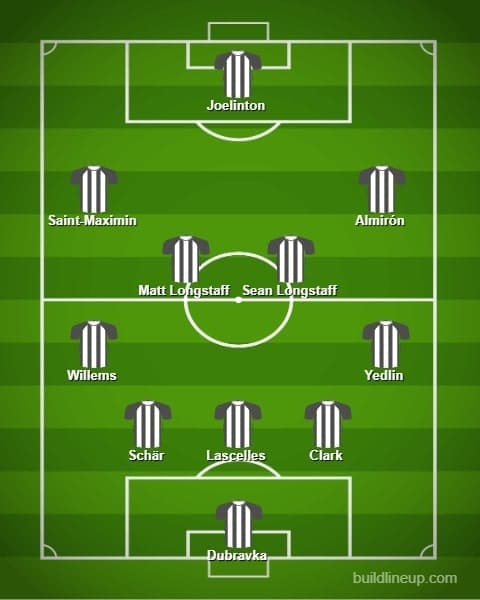
Against United and Chelsea, Newcastle were the underdogs, which suited them well. These two teams could not penetrate at the central areas much, thanks to the defensive efforts of Longstaff. In the draw against Wolves, the match was relatively more even, with Newcastle holding the ball longer. On occasions, they tried to move the ball from the back instead of only relying on transitions.
Style of play: long-ranged passing
When we compare the passing statistics of Longstaff to the rest of the team, he did quite well. Longstaff had an average of 39.7 passes per game, three more than his brother, Sean, and passed more than any others in the team. This figure somehow reflected his willingness to connect plays or receive the ball from his teammates. He played three long balls per game, and ranked the second among the midfielders, just behind Shelvey. His long passes will be discussed later.
This graph summarised all the passes from Longstaff on his debut. The passes are sorted into two major types according to the passing directions. First, some are safe back passes returned to his teammates. Second, many were diagonal passes or horizontal passes from side to side, as reflected in his playing style. He could switch the ball to the weak side of the defence and help his teammates attack in a more favourable situation. Also, given the direct style of his team, short passes were limited and there were plenty of long passes.
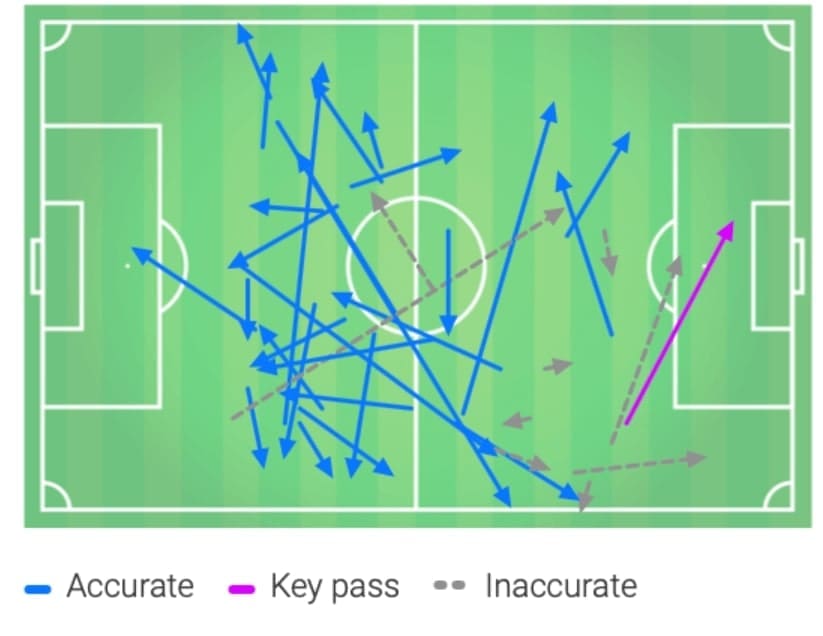
To illustrate the switch plays of Longstaff, an example from the Manchester United game was drawn. In this scene, the majority of United players were on the ball side as highlighted. Five of them were in front of Longstaff while Fred was marking Joelinton.
His brother, Sean was close to Longstaff and available as a short passing option. However, Longstaff did not go easy. Instead, he played a diagonal ball to the left side, which was quite unexpected. This display of vision and courage of Longstaff should be appreciated.
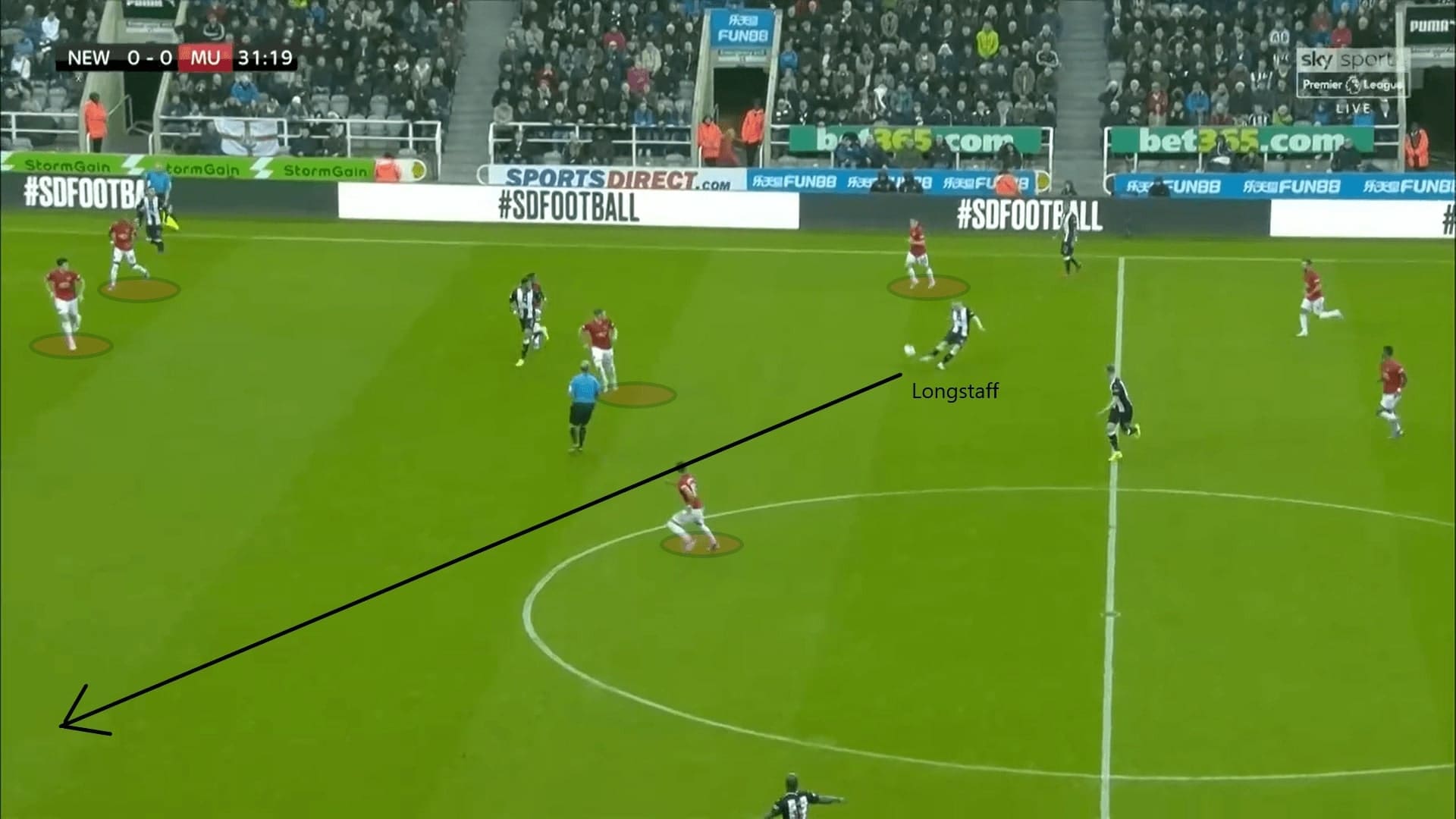
The ball from Longstaff found Saint-Maximin successfully. Given the pass from Longstaff switched the focus of attack to the weak side of Untied, Newcastle could attack with numerical equality. The French carried the ball forward while Willems made an overlapping run wide. Andreas Pereira was behind Saint-Maximin so Diogo Dalot had to choose between closing off the ball or mark Willems. At last, Willems could cross the ball into the box.
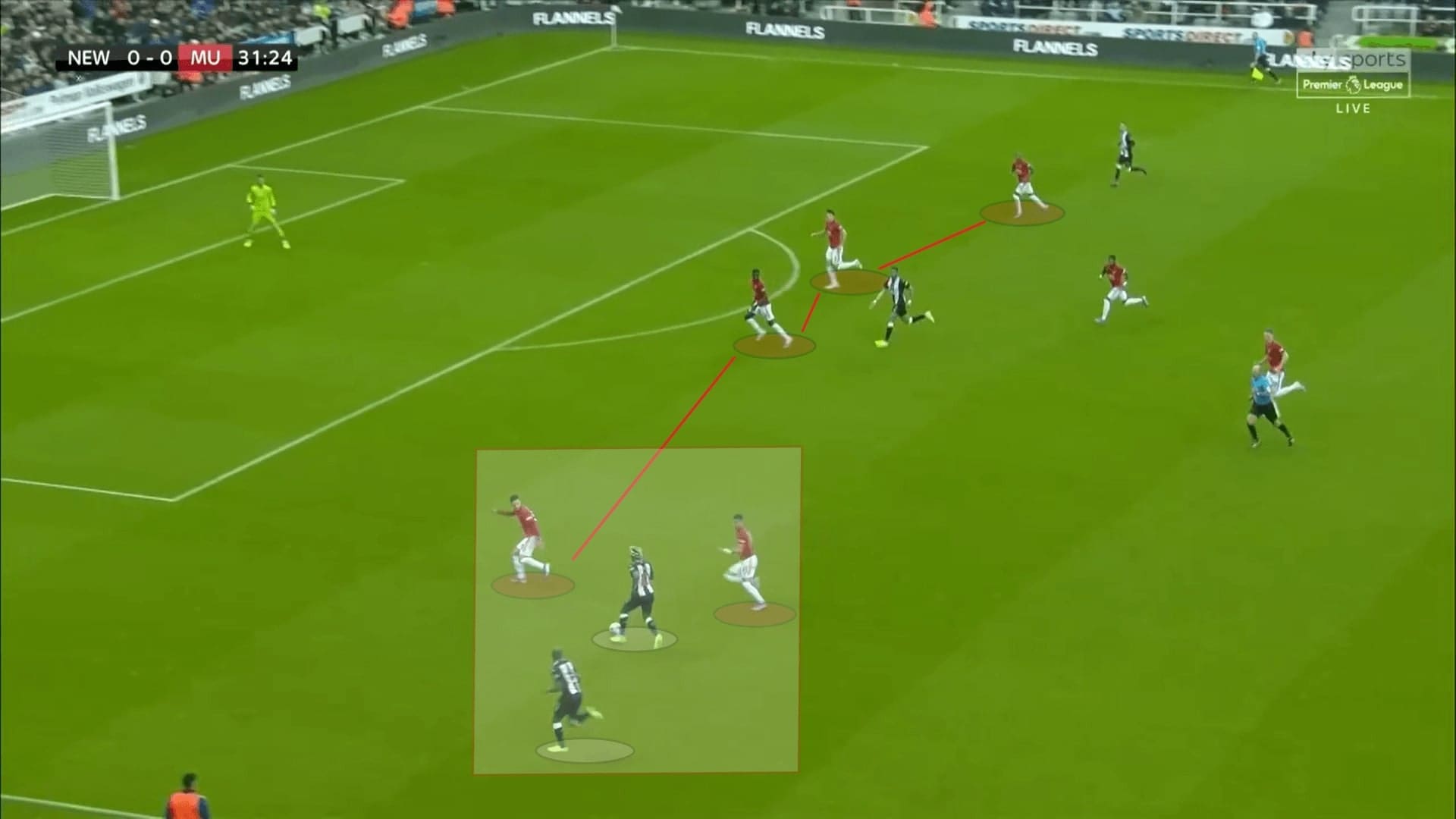
Apart from diagonal passes that switch the attacking focus, Longstaff also possessed the ability to pass behind the defenders and this directly created chances for his teammates to face the goalkeeper.
This scene was from the draw against Wolves where Longstaff created one of their biggest chances in the 33rd minute. Newcastle won the midfield battle, and Longstaff had the ball. At this moment, Rúben Neves was drawn away by Joelinton, leaving the centre of Wolves’ defence exposed. Instead of playing short, Longstaff passed to the space behind Romain Saïss and released Almirón, although the Paraguay international could not finish it. This reflected the ability of Longstaff to break the defensive line with his pass.
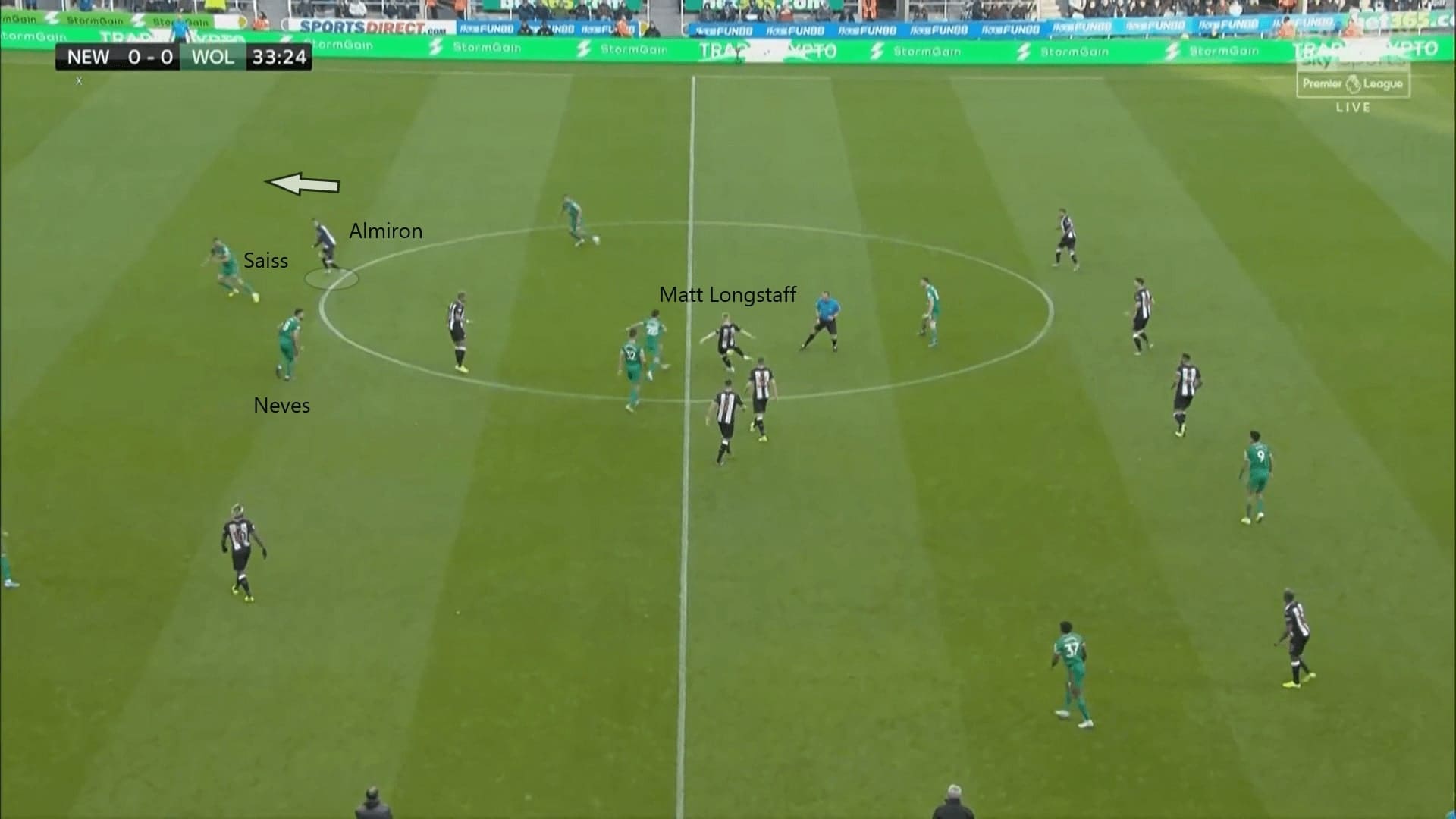
Of course, Longstaff is only 23 years old so he still has room for improvement. On occasions, he could make a better decision, including the following case. What distinguishes the world-class players from the mediocrities is their ability to create something in an instant. Although he noticed the position of Saint-Maximin and played a pass to him, Longstaff returned the ball to the defender, giving away a chance to break. For Newcastle, they must seize every chance they could to develop an attack.
He has to play and train more with the first team players since sometimes his teammates were clearly not expecting to receive a pass, which results in the ball being lost. Also, we expect to see more from Longstaff, especially the attributes not required by Bruce, like vertical passes, or the ability to dribble.
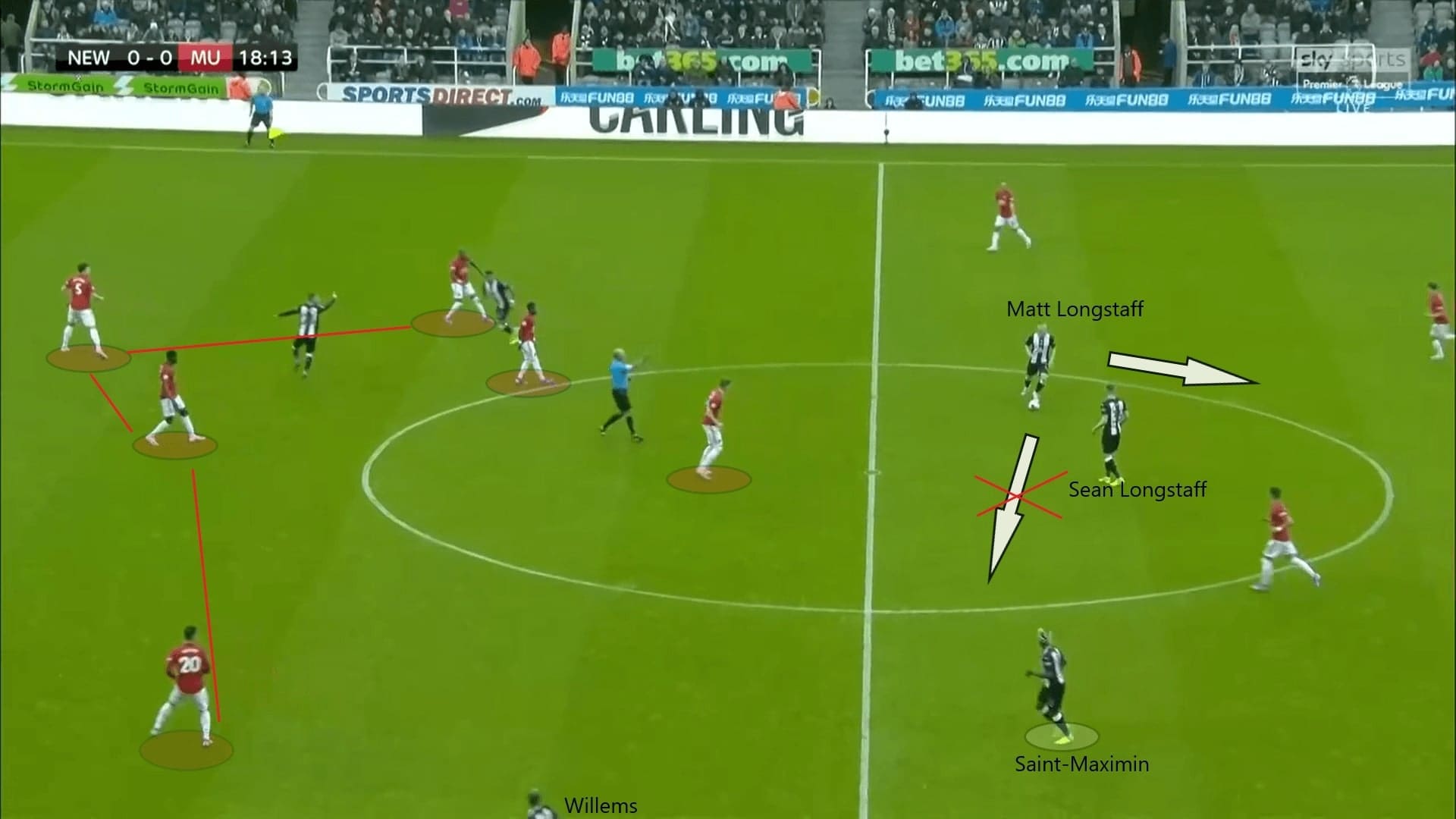
Positioning off the ball
In most cases, Bruce expects his team to maintain the defensive shape, so the job of Longstaff was to stay on the same line with his teammates. However, when situations in a match keep changing, Longstaff does quite well in this part.
As mentioned earlier, he had a brilliant game against United. Harry Maguire got room to carry the ball forward and so in this scenario, Newcastle could not maintain their block to deny opponents, with only the Longstaff brothers at the midfield.
In this case, if Longstaff went too soon to press Maguire, Mata and James would have had huge space to receive the pass from Maguire. If he moved to Mata’s side too early, Maguire could pick James with a comfortable pass. If he stayed too deep, then Maguire could continue his dribbling without pressure.
The positioning of the younger Longstaff was vital as he had to deal with both Maguire and Juan Mata, as well as taking care of Daniel James. He did enough to delay the attack of United, by staying close to his brother and at the centre. He blocked the passing lanes towards James. Maguire with no choice spread the ball to Mata, meaning Longstaff managed to control the situation.
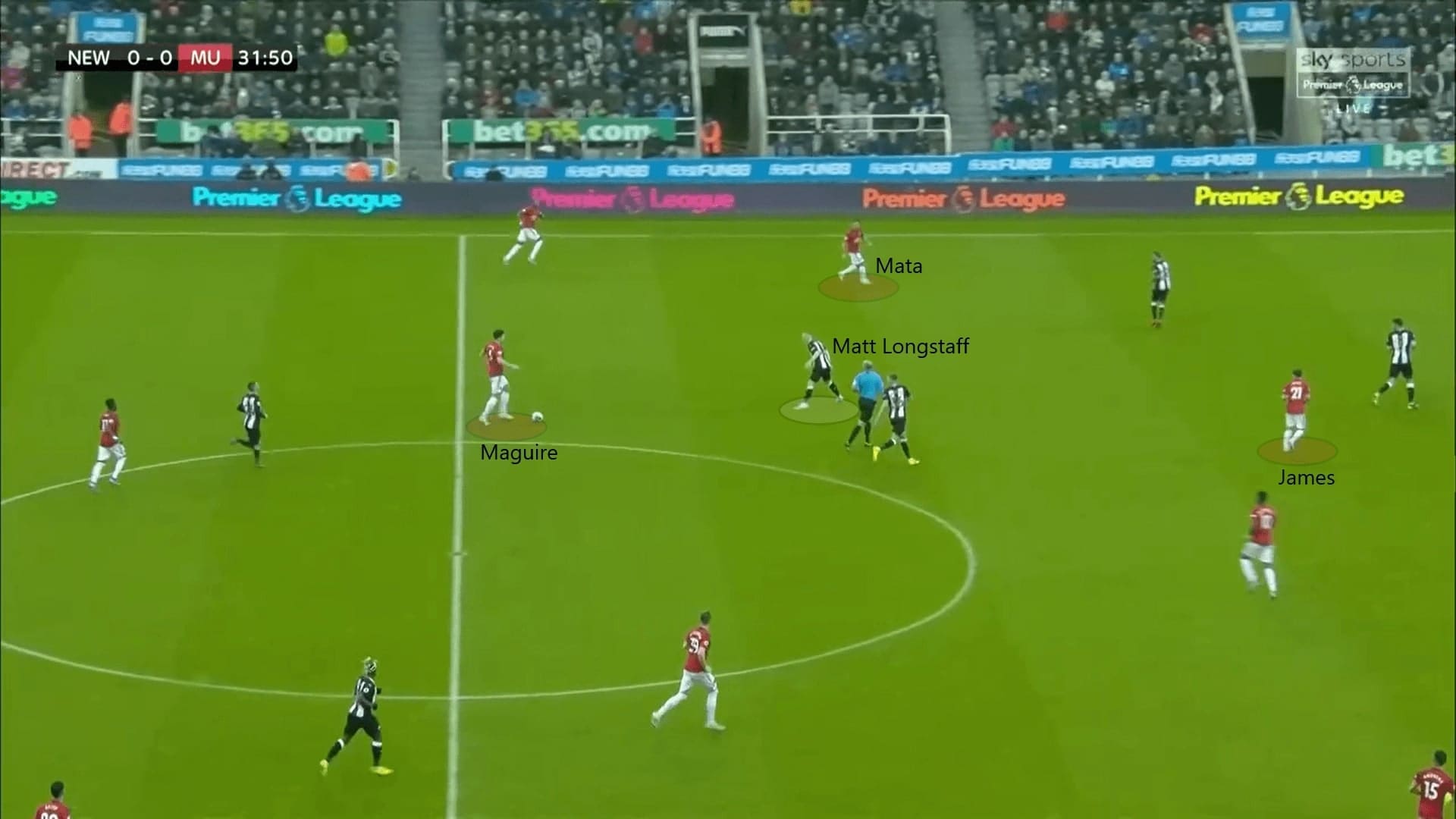
In the game against Chelsea, the job of Longstaff was like the United win: hold his position and force opponents back. Given the slight difference between United’s 4-2-3-1 and Chelsea’s 4-1-4-1 in the build-up phase, the duties of Longstaff adjusted a bit. Joelinton would take care of Jorginho, the sole pivot, while the Longstaff brothers covered Mason Mount and Ross Barkley.
In this scenario, the spaces between the Newcastle lines were huge which the Chelsea players exploited. Therefore, the positioning of midfielders was vital as they had to deny the penetrations. If the Chelsea players received the ball between the lines, they faced the defenders with numerical equality.
As in many cases, Longstaff stayed close with his brother, Sean. He did not step out to press Jorginho as the Italian was closed off by Joelinton. The positioning of Longstaff was vital to prevent a pass reaching Willian or Barkley. Jorginho did not take the risk, he played the ball wide, where Newcastle could shift their defence.
The great understanding between the brothers allowed them to start as a pair in these games as they clearly communicated with each other well.
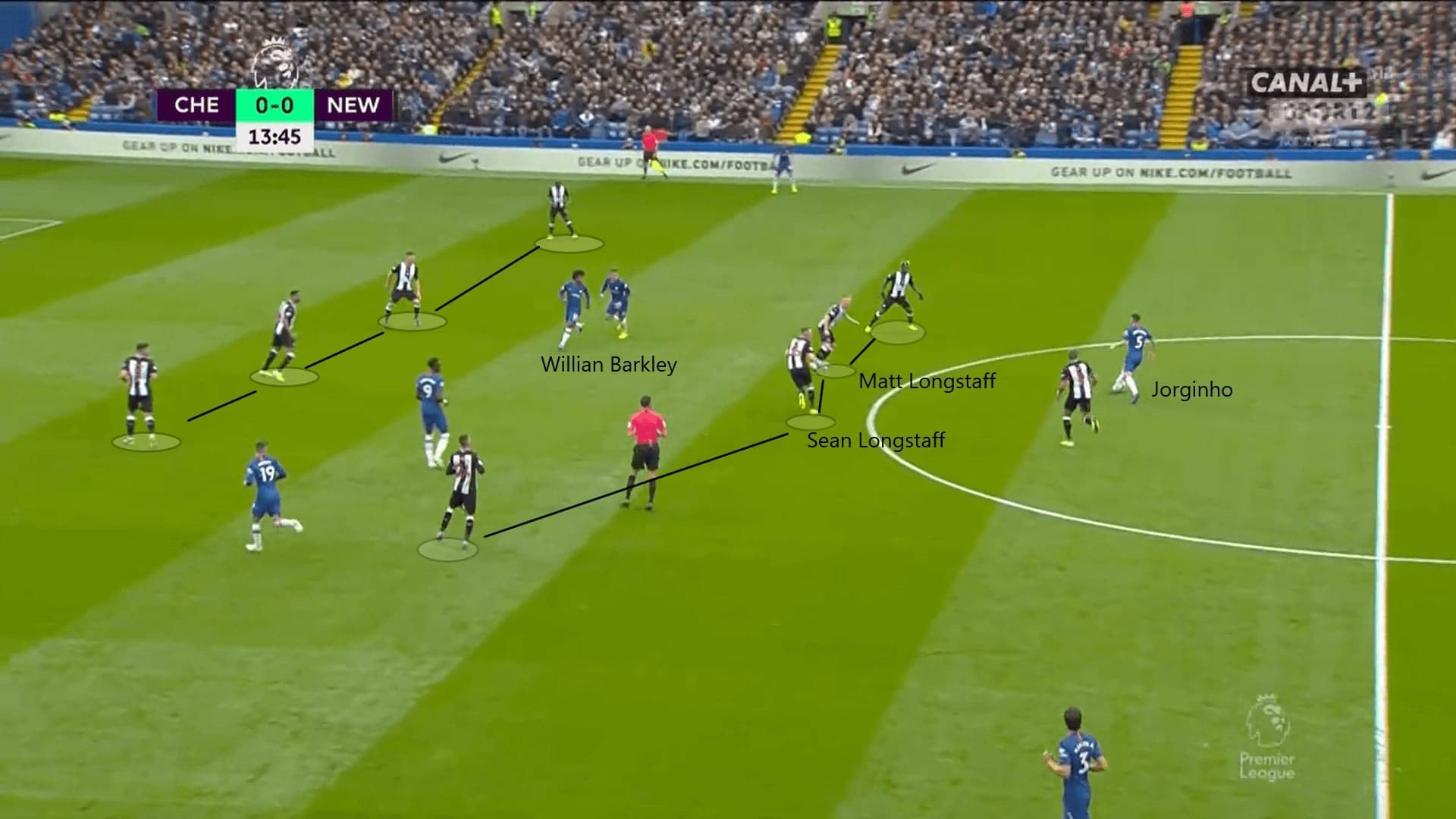
However, there were also flaws in Longstaff’s positioning. The 19-year-old Englishman has always been energetic to step out early to press the opponents, which give pressure to the ball carrier. But on several occasions, he stepped out too early and the Newcastle midfield line lost shape.
As the scene below depicts, Newcastle defended with the 5-4-1 block, while Maguire got the ball. Joelinton did not close off the former Leicester centre-back, and Longstaff stayed slightly forward to see if he could get closer to Fred or Scott McTominay, in case they receive the ball. However, the rest of the midfielders did not push higher with Longstaff, especially his brother, Sean.
Meanwhile, James and Mata positioned themselves between the lines. The positioning of Longstaff gave room for Maguire to pass between the midfielders. This violated the principle of Newcastle’s tactics – where they force the opponent to move the ball wide. Longstaff could have made that happen by staying on the same line with his teammates.
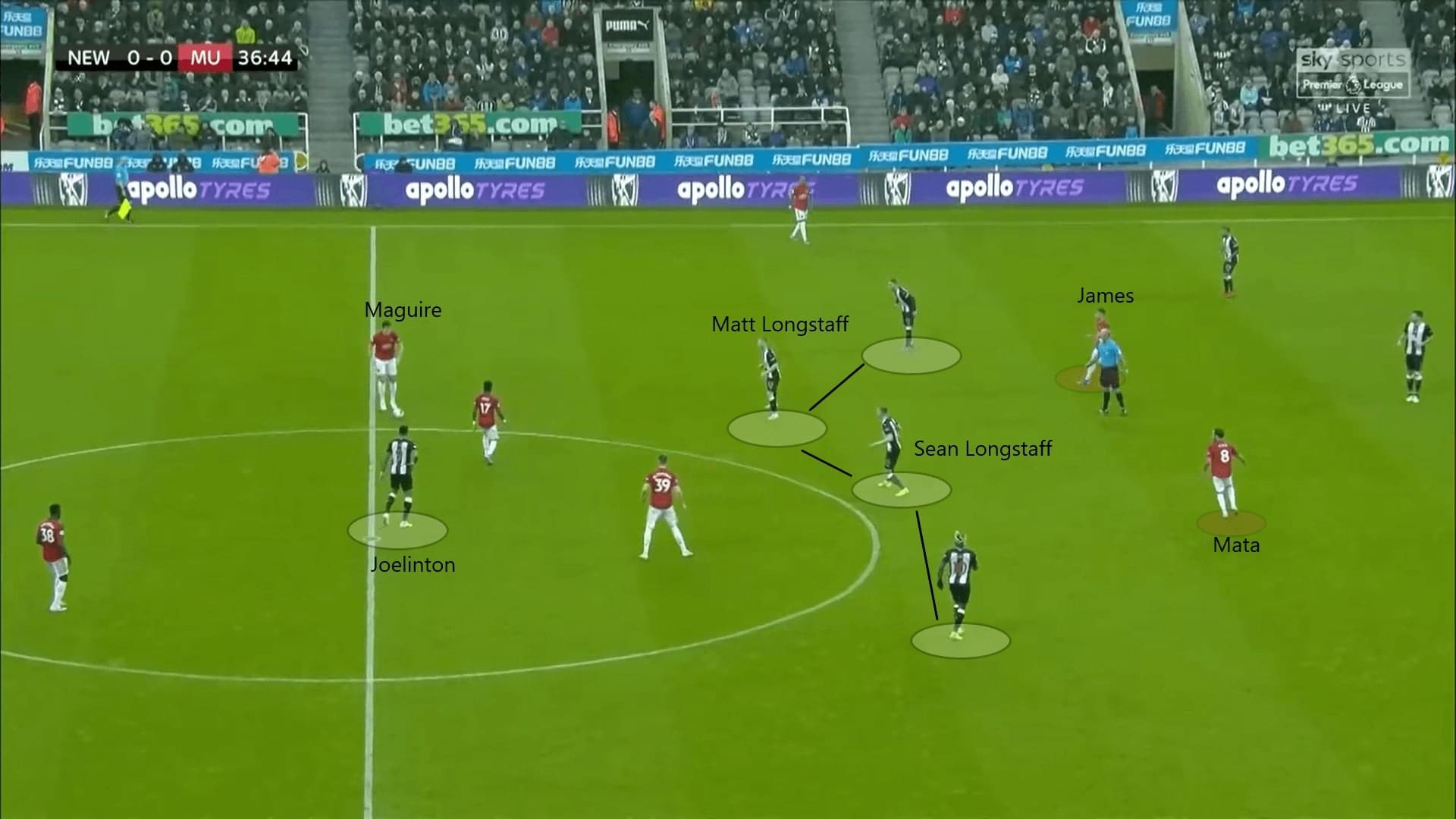
Despite staying close with his brother, Longstaff lost concentration after an hour. He tended to lose his patience and chase the ball on his own. He needs more experience and chances to play full matches in order to grow.
Weakness: Body orientation
Apart from James, United lacked quick and skilful midfielders who could take on players. In his dream victory, Longstaff didn’t face many one-on-one challenges. However, this situation happened more in the Chelsea game, since Frank Lampard’s team possesses individuals like Willian and Callum Hudson-Odoi.
By looking at the statistics, Longstaff was the worst in the team, as he was dribbled past by an opponent 2.3 times per game. This figure is the highest in the whole team, as he was constantly outpaced by Willian and Hudson-Odoi. He lacked the body strength to stop the dribbler, as well as missing the pace to chase them. However, the bigger problem was his body orientation during the defence.
The battle between Hudson-Odoi and Longstaff in the Chelsea game is a good example. Chelsea seemed to discover this weakness of Longstaff so their wingers positioned themselves more centrally and took him on. In the below scene, Jorginho progressed the ball to the attacking third. Despite his brother closing off the Italian international, Longstaff was caught looking at the ball. Hudson-Odoi then looked to exploit the spaces around Longstaff.
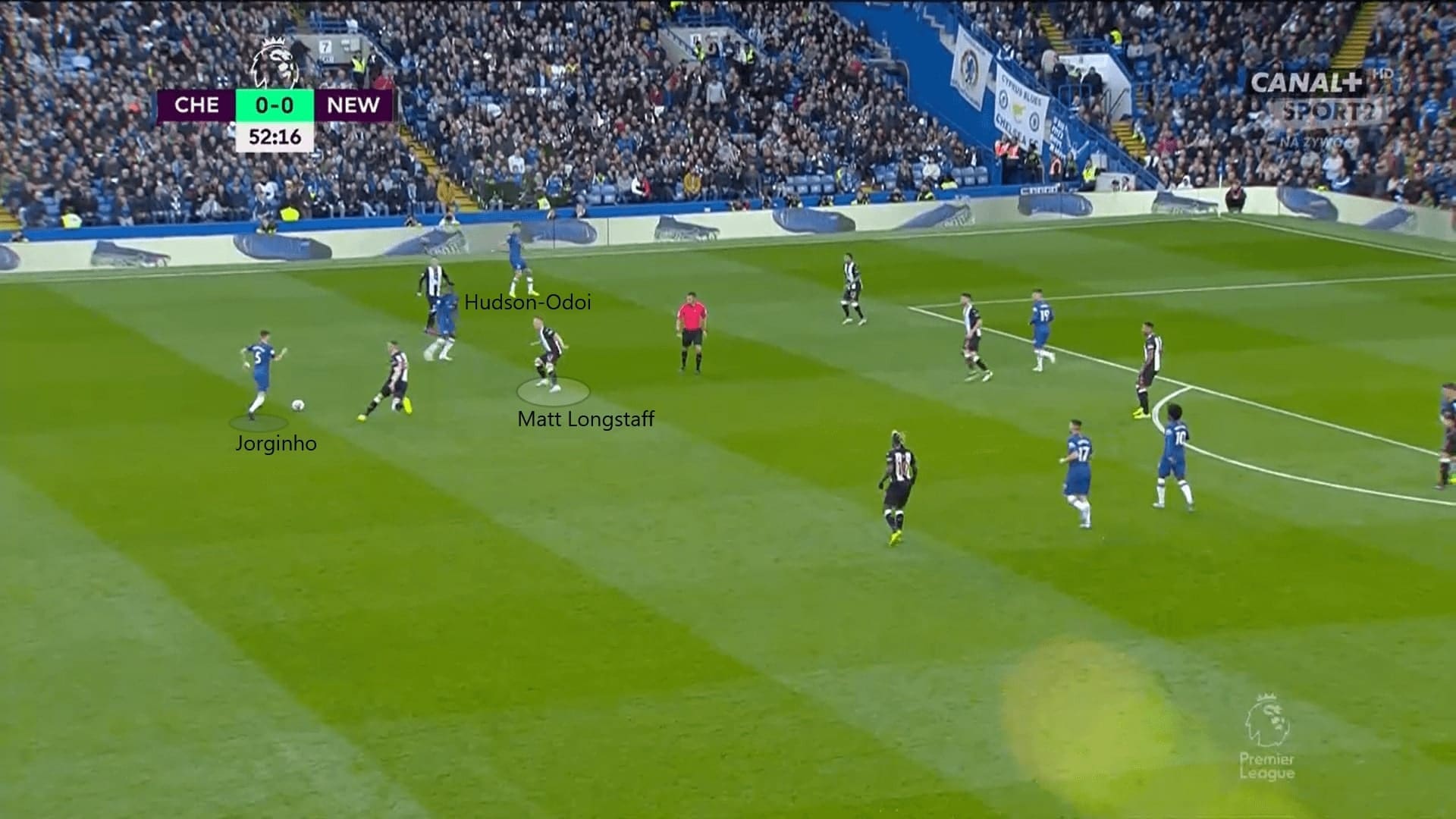
As shown above, the body shape of Longstaff, was far from perfect. He faced Jorginho directly, which constrained his movement and disallowed him to turn quickly. Therefore, he was slow to react and Hudson-Odoi easily took the ball with his left foot right beside him. Then the winger sprinted to the highlighted space where Longstaff was outpaced. Similar events also happened when he was defending against Willian.
Longstaff could have done better by slightly adjusting his body orientation towards Hudson-Odoi. With that angle, he could still see Jorginho while he could also control and monitor the movement of Hudson-Odoi.
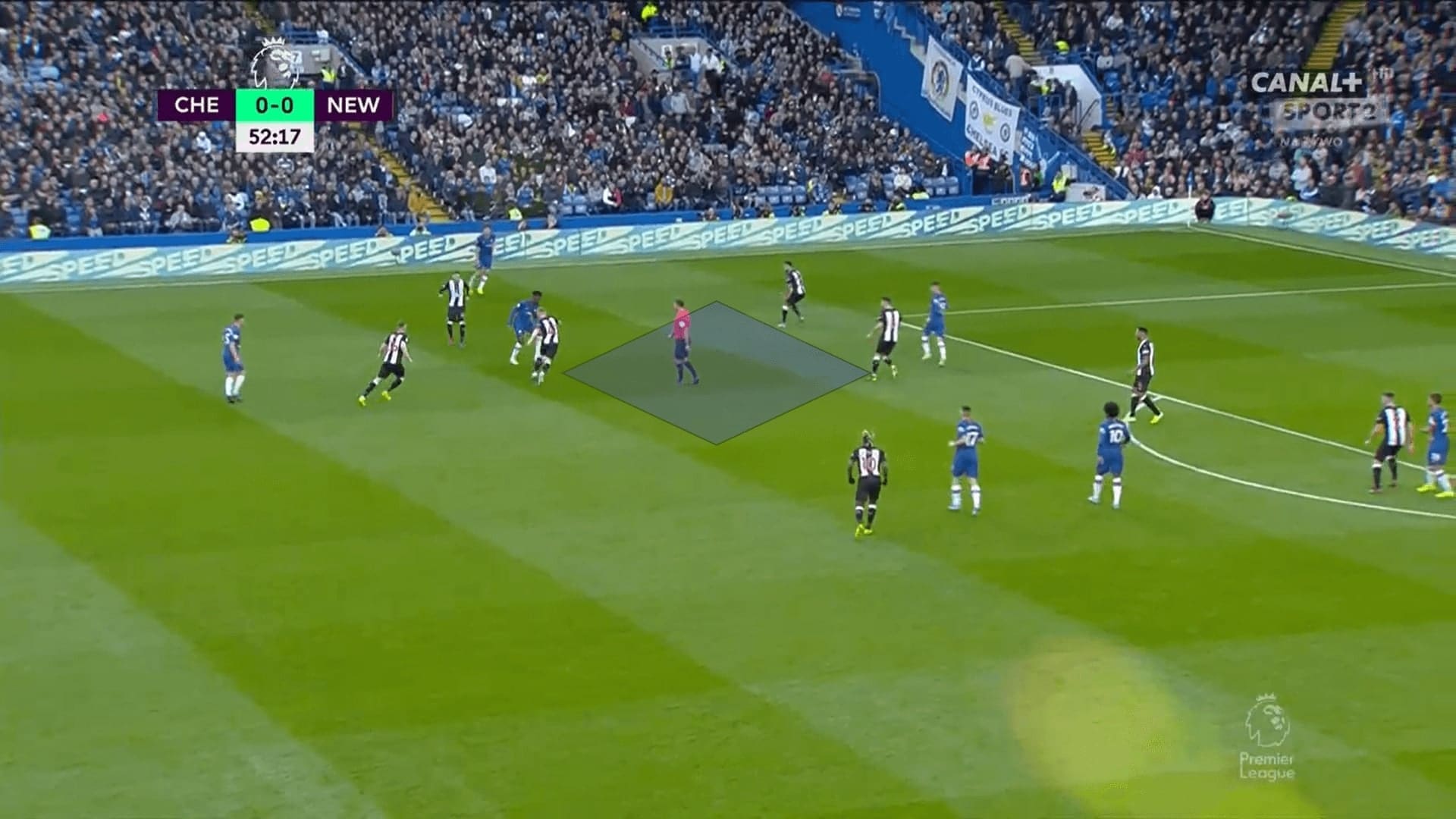
Conclusions
To conclude, Longstaff is a promising young player, who could pass long. His duty at Newcastle was mostly to cover midfielders, denying central penetration. When he gets the ball, he just kept things simple, seldom overcomplicating things. When Newcastle attack, especially if Saint-Maximin is on the ball, Longstaff does not need to provide support to the Frenchman. It is because Bruce believes in his ability that Saint-Maximin is able to enjoy room to dribble and take on players. The job of Longstaff was to retain his position and to prevent fast transitions.
On his personal attributes, Longstaff still has got more to show if he wished to play in a more attacking team. For example, the ability to pass vertically, to carry the ball, or even being a sole pivot to fight for the second balls from aerial duels. It is still early to name him as the new ‘Paul Scholes’, but he has the potential to improve.

If you love tactical analysis, then you’ll love the digital magazines from totalfootballanalysis.com – a guaranteed 100+ pages of pure tactical analysis covering topics from the Premier League, Serie A, La Liga, Bundesliga and many, many more. Buy your copy of the November issue for just ₤4.99 here





Comments